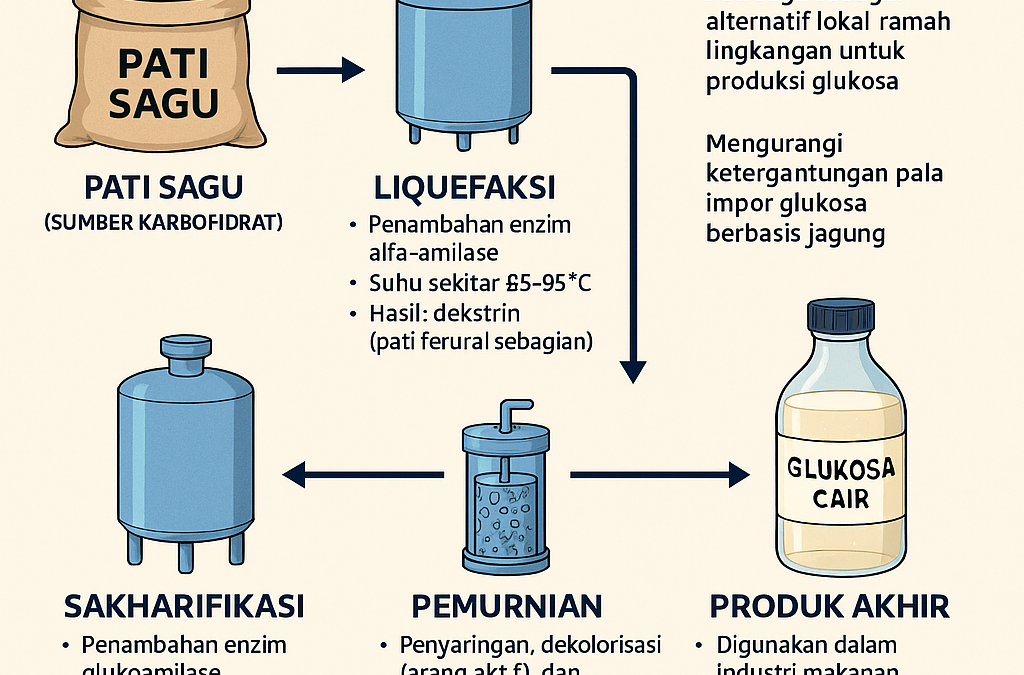Indonesia is the largest producer of sago (Metroxylon sp.) in the world. Indonesia’s sago plantations account for 51% of the world’s total, covering 1.25 million hectares. Sago is the highest-yielding source of dry starch compared to rice and corn. Sago can produce 25 tons of dry starch per hectare, while rice and corn produce only 6 and 5.5 tons per hectare, respectively. Another advantage of sago over other starch-producing crops is that its cultivation technology is relatively simple, straightforward, and more economical.
As the largest starch producer, sago has great potential to be developed as a food source and as a raw material for synthesizing starch-based derivative products. One such derivative is liquid glucose, which is being developed through an innovative initiative by the Industrial Chemical Engineering Technology (TRKI) Program at Undip Vocational School—namely by Mohamad Endy Julianto, Malika Pintanada Kaladinanty, and Abitha Mona Wisya.
Malika explained that currently, liquid glucose is produced from cassava and corn. Liquid glucose is used as a sugar substitute in industries such as candy, beverages, and biscuits. It helps improve smoothness, lower the freezing point, prevent microbiological damage, and enhance texture. Indonesia’s domestic need for liquid glucose is only about 60% fulfilled. Indonesia imports up to 112,396 kg of glucose syrup. The demand for sweetening agents in the industrial world continues to grow in line with the development of its user industries, Malika stated.

Researchers: Malika and Abitha
To synergize efforts in diversifying and developing sago-based products and to increase national self-sufficiency in meeting sweetener demands—particularly liquid glucose—it is necessary to develop the process of producing liquid glucose from sago starch, said Abitha. Abitha revealed that liquid glucose is made through the hydrolysis of starch. Hydrolysis can occur through acid or enzymatic processes. In making glucose syrup, the choice of starch source must consider its amylose and amylopectin content. Starch with high amylopectin is preferred because it contains ISP (Insoluble Starch Particles) that can be hydrolyzed either by acid or enzymes. Starch should also be low in protein and fat content, as these can trigger the Maillard reaction, which causes browning in liquid glucose. Sago starch has relatively high amylopectin and is low in both protein and fat, making it ideal as a raw material for producing liquid glucose, Abitha added.

Supervisor: Mohamad Endy
Meanwhile, Endy added that enzymatic hydrolysis of sago starch using a tubular membrane reactor appears very promising for further development. Enzymatic hydrolysis offers many advantages over conventional acid-based hydrolysis, such as: higher conversion to D-glucose (up to 97%), lower operating temperatures, no need for corrosion-resistant equipment, no impact on product color, Reduced chemical usage due to no neutralizing agents required, no salt precipitates produced. Endy further explained that the membrane reactor integrates two processes: enzymatic saccharification and separation. The separation process uses a membrane to selectively separate larger particles based on their physical dimensions. During hydrolysis, hydrolyzed products are separated with simultaneous recycling of undigested substrates and enzymes. Enzymes can be recovered and reused.
One major advantage of using a membrane reactor is the simultaneous separation and removal of inhibitory compounds from the reaction medium through membrane pores. Substrates are continuously fed into the reactor to compensate for permeate flux and to maintain constant reactor volume. The application of membrane reactors in hydrolysis enables process modification and control of reaction conditions such as pH, temperature, starch concentration, enzyme dosage, Endy concluded.


Recent Comments